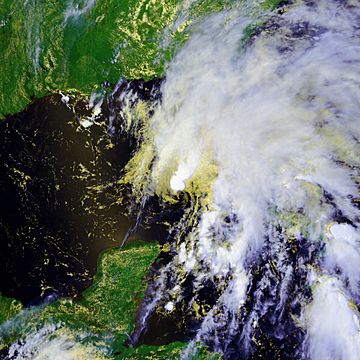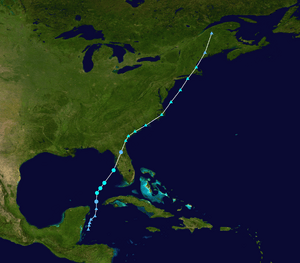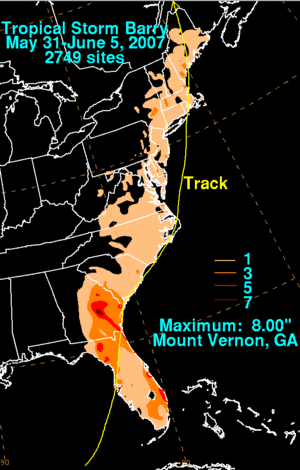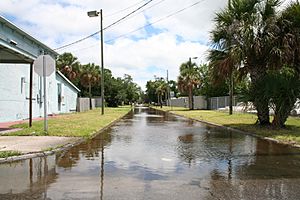Tropical Storm Barry (2007) facts for kids
| Tropical storm (SSHWS/NWS) | |

Tropical Storm Barry
|
|
| Formed | June 1, 2007 |
|---|---|
| Dissipated | June 2, 2007 |
| Highest winds | 1-minute sustained: 60 mph (95 km/h) |
| Lowest pressure | 997 mbar (hPa); 29.44 inHg |
| Fatalities | 1 direct, 2 indirect |
| Damage | Minimal |
| Areas affected | El Salvador, western Cuba, Florida, East Coast of the United States |
| Part of the 2007 Atlantic hurricane season | |
Tropical Storm Barry was a tropical cyclone that formed quickly in June 2007. It was the second named storm of the 2007 Atlantic hurricane season. Barry started in the Gulf of Mexico and moved northeast. It reached its strongest winds of 60 mph (95 km/h).
Barry then weakened and hit land near Tampa Bay, Florida. It lost strength fast because strong winds blew away its thunderstorms. Barry moved up the East Coast of the United States. By June 5, a larger weather system absorbed what was left of Barry.
Barry caused rain in Cuba, hurting three people and damaging 55 houses. In Florida, Barry brought much-needed rain to areas that were very dry. Sadly, two people died in car accidents due to wet roads. One surfer died in Pinellas County, Florida, because of rough seas. The rain from Barry helped firefighters put out bad wildfires in Florida and Georgia. The storm caused only minor damage overall.
Contents
How Tropical Storm Barry Formed
On May 29, 2007, a weather system near the Yucatán Peninsula started to create thunderstorms. These thunderstorms grew stronger. By May 30, clouds from this area stretched from Nicaragua to the southeastern Gulf of Mexico.
Another weather system, called a tropical wave, also helped form the storm. On May 31, a cyclone began to form within these systems. The storm moved north-northeast and slowly got stronger. More thunderstorms formed near its center. This system then became a tropical depression. A tropical depression is the first stage of a tropical storm.
Barry Becomes a Named Storm
The tropical depression developed sudden, strong storms with wind and rain, called squalls. A special airplane, called a Hurricane Hunters plane, flew into the storm. They collected important information about it. At first, the storm seemed to be a mix of a tropical and subtropical cyclone.
On June 1, the National Hurricane Center officially named the storm Tropical Storm Barry. At this time, Barry was about 235 miles (375 km) west of Key West, Florida. Barry moved quickly towards the north. On June 2, it reached its strongest point with winds of 60 mph (95 km/h).
Barry Weakens and Disappears
After reaching its peak strength, strong wind shear hit Barry. Wind shear is when winds blow in different directions or speeds at different heights. This wind shear blew away most of Barry's thunderstorms. The center of the storm stretched out, and it began to weaken.
At 1400 UTC on June 2, Barry hit land near Tampa, Florida. By then, it was just a tropical depression. As Barry moved further inland, it weakened even more. Later that day, the National Hurricane Center announced that Barry had ended over northeastern Florida.
What was left of Barry kept moving northeast. On June 3, it moved onto shore again in South Carolina. By late on June 4, the storm had become an extratropical cyclone and entered New England. Finally, late on June 5, a larger weather system took over the remains of Barry. This happened near the border of Maine and Quebec, Canada.
Getting Ready for Barry
When Barry was named a tropical storm, the National Hurricane Center issued a tropical storm warning. This warning was for the west coast of Florida, from Bonita Beach to Keaton Beach. They also issued a tropical storm watch further north.
Warnings were also sent for many inland parts of Florida. Officials warned swimmers to stay out of the water because of dangerous rip currents. A tornado watch was issued for southern Florida, but it was later canceled.
After Barry became an extratropical cyclone, weather offices issued flood watches. These watches were for parts of South Carolina, eastern North Carolina, southeastern Virginia, and southeastern Maryland. Flood watches also covered parts of Pennsylvania, Delaware, New Jersey, New York, and southern New England. A wind advisory was sent out for parts of Georgia.
What Barry Caused
Impact in Florida
Barry brought a lot of rain to Florida. The most rain, 6.99 inches (178 mm), fell at Palm Beach International Airport. Other areas received over 3 inches (75 mm) of rain. This rain was very helpful because it eased drought conditions. It also helped firefighters battle serious wildfires across the state.
In Brevard County, the rain caused a large sinkhole to open in the middle of a road. Other roads were flooded. On Interstate 95, near Lake Worth, another sinkhole closed two lanes of traffic. Wet and slippery roads led to many car accidents. In Brevard and Volusia counties, drivers died in traffic accidents. On Interstate 4, a large truck crashed into a guardrail because of the weather.
The storm also caused rough seas along Florida's coast. The water level rose by 4.78 feet (1.46 m) at Clearwater Beach. These waves caused minor beach erosion. The high water also led to minor flooding on many roads near Tampa Bay. At Indian Shores, a woman died after being hurt by the high seas.
Barry brought strong winds to Florida, reaching 47 mph (76 km/h) near the southeastern coast. These winds knocked down trees and caused power outages. In Carrolwood, one person was injured when a tree fell onto their house. The storm also created at least two tornadoes. Some of these tornadoes damaged fences and power lines. One possible tornado in Goulds, Florida, left about 2,000 people without electricity.
Impact in Other States
| Location | inch | mm |
|---|---|---|
| West Palm Beach, Florida | 6.99 | 178 |
| Mount Vernon, Georgia | 8.00 | 203 |
| Near Hardeeville, South Carolina | 6.12 | 156 |
| Fuquay-Varina, North Carolina | 3.73 | 94.7 |
| Pennington Gap, Virginia | 3.75 | 95.3 |
| Frostburg, Maryland | 1.70 | 43.2 |
| Dover, Delaware | 1.54 | 39.1 |
| Philadelphia, Pennsylvania | 1.66 | 42.2 |
| Absecon, New Jersey | 4.50 | 114 |
| Central Park, New York | 3.91 | 99.3 |
| Berlin, Connecticut | 2.90 | 73.7 |
| Taunton, Massachusetts | 3.19 | 81.0 |
| Burrillville, Rhode Island | 3.10 | 78.7 |
| Newmarket, New Hampshire | 2.75 | 69.9 |
| Saco, Maine | 2.64 | 67.1 |
The storm also caused heavy rain in Georgia, with up to 8 inches (203 mm) in some places. This rain helped put out wildfires. It also caused some minor flooding. In Savannah, there were a few minor car accidents. Winds blew down some trees and power lines.
Heavy rain from the storm moved across much of the East Coast of the United States. Strong winds also occurred in South Carolina. The remains of Barry caused winds up to 60 mph (97 km/h) near Charleston, South Carolina. About 200 houses in Craven County, North Carolina lost power.
In southeastern Virginia, the storm caused over 60 car accidents. Ten people were injured in these accidents. High seas off Cape Fear meant a sailboat with three people needed rescue from the Coast Guard.
Rain continued north into the Mid-Atlantic States and New England. Absecon, New Jersey received 4.50 inches (113 mm) of rain. Near Central Park, New York, 3.91 inches (99 mm) fell. Taunton, Massachusetts saw 3.19 inches (81 mm). Several roads and driveways were damaged by flooding in the Finger Lakes region of New York State. Flash floods happened in southeast New York. Strong wind gusts also caused some damage to trees. In New Jersey, winds pushing over land caused high tides and minor coastal flooding.
Tornadoes Caused by Barry
| List of confirmed tornadoes – June 1, 2007 | ||||||
|---|---|---|---|---|---|---|
| "Rating" | Location | County | Location | Time (UTC) | Path length | Damage |
| Florida | ||||||
| EF0 | East-northeast of Sugarloaf Key | Monroe | 24°40′N 81°31′W / 24.66°N 81.52°W | 1655 | 0.6 miles (1.0 km) | A brief tornado touched down. It knocked down a 30-foot ficus tree, causing minor damage to two homes. This caused $20,000 in damages. |
| EF1 | Cutler Bay area | Miami-Dade | 25°34′N 80°21′W / 25.57°N 80.35°W | 0145 | 3.9 miles (6.3 km) | This tornado uprooted some large trees and broke off many big branches. It also caused roof and fence damage to homes. This caused $20,000 in damages. |
| Sources: NCDC Tornado database files |
||||||
Related pages
- 2007 Atlantic hurricane season
- List of tropical cyclone names
- List of hurricanes in Florida
- List of hurricanes in Connecticut
|
Tropical cyclones of the 2007 Atlantic hurricane season |
|||||||||||||||||||||||||||||||||
|
|
||||||||||||||||||||||||||||||||
|
|
|||||||||||||||||||||||||||||||||
Images for kids
See also
 In Spanish: Tormenta tropical Barry (2007) para niños
In Spanish: Tormenta tropical Barry (2007) para niños






